This stamp is finely crafted in the form of a classical female bust, likely inspired by Renaissance or Neoclassical ideals of beauty. Made of silver, its quality and detailing suggest it was produced as a high-end object, probably in the 19th century. The fact that the handle takes the shape of a woman’s bust, combined with the round shape of the seal itself, indicates that it was likely used by - or created as a gift for - a noblewoman. Bust-shaped handles were typically bespoke, emphasizing the unique and personal nature of this piece.



Metal in the Art of Wax Sealing. Forged for Duty or Chiseled for Beauty.
Wax seal stamps made entirely of metal were crafted across a wide spectrum of intent, from strictly utilitarian to exquisitely ornamental. The more functional examples were often made of bronze, brass, or iron, with faceted or cylindrical handles designed for durability and ease of use. Their strength and resistance to wear made them practical tools, often with minimal decoration. Despite their austerity, these stamps still carried finely engraved matrices bearing coats of arms, monograms, or institutional emblems, functionality paired with a certain dignity. At the other end of the spectrum were decorative metal stamps, especially those made of chiseled silver or shaped into sculptural forms. These were often commissioned by or gifted to members of the nobility or affluent bourgeoisie. Some silver examples were delicately embossed with floral or Rococo motifs, while others took imaginative forms such as women’s busts, allegorical figures, or architectural elements. Such elaborate stamps indicated refinement, and personal identity. In these cases, the object transcended mere utility and entered the realm of personal luxury, small masterpieces of decorative art, held in the palm of the hand.

This intriguing seal stamp was acquired from Italy and dates back to the 16th century. It was very rusted, so I cleaned it using ultrasound. A beautifull coat of arms was then revealed, belonging to the Sicilian Imperato di Spinete family. These particular arms represent the branch of the Marquises of Spinete and are described as follows: Azure, quartered by a gold fillet, 1st Quarter: Two lions facing each other, with a gold crown above, 2nd Quarter: A silver band (Argent) with three stars, 3rd Quarter: A crowned lion in gold (Or), 4th Quarter: Another lion in gold (Or). The discovery of this well-preserved coat of arms adds a rich historical dimension to the piece, highlighting its noble origins. The Imperato family, originally from Sicily, rose to prominence through military and diplomatic service. The branch of the family that held the title of Marquis of Spinete distinguished itself through its loyalty to the Spanish monarchy, which controlled Sicily and southern Italy for much of the early modern period.




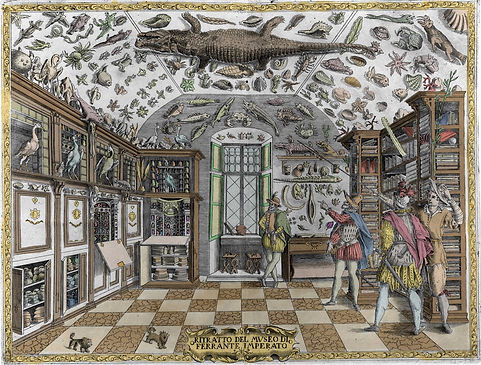

This seal stamp belonged to Gaston Henri Denis de Senneville and Marie de Grave, or one of their descendants. The quartered coat of arms engraved on the seal combines the arms associated with the Denis de Senneville family and those of the de Grave lineage. This same quartering is documented in modern armorial sources and confirms that the seal does not represent a simple marriage alliance but the creation of a lasting family branch. The de Grave family belonged to an old and prestigious lineage of southern France, traditionally linked to the region of Montpellier and to noble service at a high level. Its members included Pierre-Marie de Grave, Lieutenant-General and Pair de France, and Henri de Grave. The Denis de Senneville family, by contrast, represented solid provincial nobility, established through landholding rather than great court rank. Jacques Denis is regarded as the earliest ancestor of the Senneville line.





Henri de Grave, Marquis de Grave

Coat of arms of Pierre-Marie de Grave

Jacques Denis
This finely detailed wax seal stamp is made of silver. It is really beautifully decorated. This stamp belonged to a noblewoman. A Countess. We can notice it because the shield is round, and of course the crown is the one of a Count. It is a high-quality, bespoke object, made by a silversmith skilled in doing Rococo or Empire-style ornamentation, perhaps leaning toward the Neoclassical style popular in France, Austria, or the German states around 1800–1850.
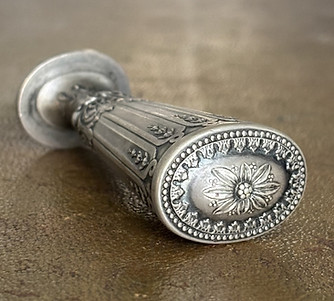


While the Art Nouveau-style handle of this beautiful silver seal stamp reflects a refined aesthetic popular between 1890 and 1910, the coat of arms engraved on it belongs to Chef de Bataillon Pierre-Joseph-Michel Vivien, who was granted the title of Knight of the Empire by Napoleon in 1809. This may suggest that the stamp likely belonged to one of his descendants, rather than to Pierre himself.


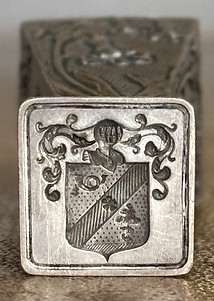
Trying to find the origin of this metal stamp bought from Germany is challenging. It may represent a marital or hereditary alliance, possibly forged under the Habsburg monarchy (1526–1918), which ruled over a vast and ethnically mixed territory. The monarchy was also called the Austrian Monarchy, and later the Austro-Hungarian Empire (1867–1918). The center crest of the arms is a double cross (two barred) rising from a crescent, very typical of Hungarian heraldry. The right crest shows an armored man with an axe, commonly seen in Slovak, Polish, or Transylvanian heraldry. It could potentially reference the Topór coat of arms of Poland. While Hungary is a landlocked country, we can in the shield one quarter which contains an anchor, symbolic of seafaring or naval command. This may point to a Baltic port family (e.g. Gdańsk, Riga) or even a Croatian family from the Adriatic coast, which was also part of the Habsburg lands. So, this seal likely belonged to a noble family of mixed heritage, combining Hungarian and Slovak roots with a coastal, Baltic, or Croatian influence (anchor).


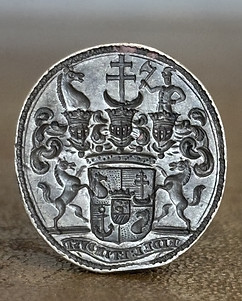



This seal, made of a single piece of metal, belonged to a member of the German family von Mohl. It is a family of officials who have been active in the Duchy of Württemberg since the 16th century, and who received an imperial coat of arms in 1608. The family line begins with Jacob Mohl. In 1811, the Royal Württemberg State Councillor Benjamin Ferdinand von Mohl was awarded the Civil Order of Merit of the Württemberg Crown and thus the personal nobility, as did his son Robert von Mohl in 1837. As Grand Duchy of Baden Real Privy Councillor and President of the Chamber of Auditors, he then received the hereditary Baden nobility. The coat of arms from 1871 shows a bend Argent charged with three newts Vert on a field Or. The crest is a lion holding four interlaced black branches between its paws.

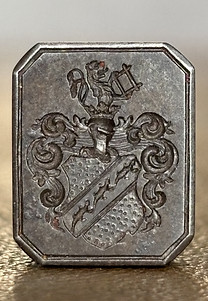



Robert von Mohl (1799 - 1875)

Ottmar von Mohl (1846 - 1922)

Hugo von Mohl (1805 - 1872)
This is a tiny piece in my collection of antique wax seal stamps from European noble families. Very small. It is a cute (fancy?) little stamp, but the engraving is not so fine. Of course, it might be difficult to engrave such a small area. The crown looks a bit like a Miss Universe type of crown... This might not be a "standard" coat of arms registered in an armorial, but it very likely belonged to a real person or family.



This seal stamp from the mid-19th century was bought from Berlin, Germany. It is rather light, since it not made of heavy bronze. The bronze is coated in silver, and we can see the coating wear out at various places. But still is quite elegant. The three owls symbolize a lineage of wisdom and Strategic foresight in leadership.




The crown on this simple coat of arms could be a bit misleading. It looks like a combination of the characteristics of both the crowns of a Baron and a Count. But this type of heraldic crown is used for hereditary Knights (Erfridder), or untitled nobles, by the nobility of The Netherlands. Millrinds are common symbols in the heraldry of The Netherlands. The Netherlands historically had a dense network of watermills and windmills, essential for grinding grain, pumping water, and sawing.



A striking “Norman Soldier” stamp featuring the coat of arms of the English Corbet family. The name Corbet comes from corbeau, the French word for raven, and is among the oldest Norman surnames in England. The Corbet of Moreton branch descended from this prominent Norman lineage, which settled in Shropshire after the Norman Conquest of 1066. With deep roots in the Welsh Marches, the family developed several branches, including the senior line based at Moreton Corbet Castle, a partly ruined manor that still stands today. Sir Andrew Corbet (1522–1578) was a notable figure of this branch. The elephant crest, unique to the Moreton Corbet line, is an unusual heraldic symbol, likely adopted to represent strength and noble character.









A small 5.5cm high all metal stamp from Germany, but of unknown family origin. What is interesting to me is the presence of the horse as the crest, together with what seems to be the wings of eagle. To me, this is not a winged horse, but rather a combination of it with ceremonial wings that are often seen above the shield in German coats of arms.



This elegantly crafted silver seal stamp belonged to a member of the Swiss Lullin family. While the Lullin family held considerable influence in Geneva, they were not traditionally part of the hereditary nobility. Their prominence stemmed from their standing within the Genevan patriciate, a civic elite whose authority was rooted in wealth, education, and public office rather than feudal landownership or ennoblement. As a Republic, Geneva generally did not recognize hereditary noble titles and instead upheld republican ideals. However, historical records mention Gaspard de Genève as Marquis of Lullin in 1597. This suggests that the Lullin and Genève-Lullin families were likely branches of the same lineage, with "Genève-Lullin" designating a cadet or merged line. In another branch, Jacques André Lullin was Marquis de Chateauvieux. This explains the marquis's coronet above the shield.





Ami Lullin, Lord of Jussy

Jacques-André Lullin, marquis de Châteauvieux

Jacques André Lullin Lullin de Châteauvieux
This stamp looks like an ancient “travelling wax seal stamp”, used by the nobleman while he was on the way to the battlefield. Or at least that it what I like to think. The handle appears to be hand-forged iron or early steel, with an irregular, hammer-finished surface. The shape is simple and utilitarian, suggesting it was meant primarily for function rather than display. This utilitarian finish is consistent with late medieval to early modern craftsmanship, possibly 16th to early 18th century.



This beautiful silver seal is engraved with the Polish Doliwa coat of arms. In Poland, coats of arms functioned differently than in Western Europe. The Doliwa arms were used by several noble families of the szlachta during the Polish-Lithuanian Commonwealth, representing a heraldic clan rather than a single lineage. Dozens of families - often unrelated by blood - shared the same arms. They all belonged to the ród herbowy Doliwa, though their surnames could vary widely. Membership in such a heraldic clan implied a shared noble identity, not literal kinship. The traditional Doliwa design consists of an azure background with a diagonal stripe and three roses. Descendants of nobles already belonging to the Doliwa clan were entitled to bear the arms. In medieval Poland, however, a family could also be adopted into a heraldic clan through the practice known as adoptio in nobilitatem, especially when forming alliances, founding new branches, or acquiring land tied to a clan. This practice declined after the 15th century. In addition, when the king ennobled an individual, he could either grant them new personal arms or assign them to an existing heraldic clan. Thus, a newly ennobled family might be placed within the Doliwa clan by royal decree. One notable historical figure bearing this name and coat of arms was Jan Chryzostom Pasek h. Doliwa (c. 1636-1701), a famous diarist of the Baroque era.





A Polish noblewoman of the Doliwa clan

The Doliwa coat of arms
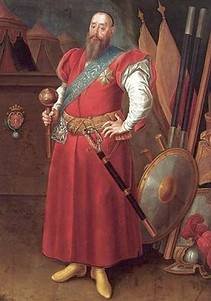
Jan Chryzostom Pasek (1636-1701)



Ignacy Łyskowski, bearer of the Doliwa-arms.
This is another very old all-metal wax seal stamp. The handle is faceted and angular, made of solid metal, likely steel or silver alloy, with a geometric and robust form. The octagonal base and sharp-cut silhouette are typical of 18th to early 19th-century Central European utilitarian seals, particularly those made for official or noble correspondence. It lacks decorative flourishes, emphasizing function over form, which is typical of many German or Dutch seals of that period.


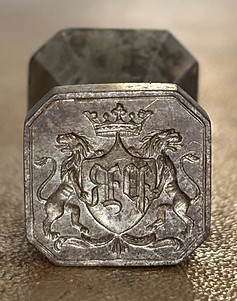
A late 19th century stamp made of silver, and engraved with the arms of the Austrian Rainer zu Harbach (or von Harbach) family. The Rainer zu Harbach was a family of merchants that was nobilised in 1755 and 1790 to the Duchy of Carinthia. The Duchy was located in the southern Austria and parts of the northern Slovenia. It was separated from the Duchy of bavaria in 976. Johann of Rainer zu Harbach (born 1782) was a founder of lead mines in Bleiburg, Petzen and Feistritz. Through his white lead factory, he became one of the best-known Carinthian industrials. He owned the estates of Freyenthurn, Rothenthurn and Harbach.





Georgine and Dora von Raine zu Harbach

Coat of arms of the family Rainer zu Harbach

Johann Ritter von Rainer zu Harbach
This is an old seal stamp of German or Austrian origin. The handle is sculpted as a bust of a young boy. This personalized piece was possibly especially made for a noble child or a family heirloom. It was crafted in the late 18th or early 19th century, possibly in southern Germany or Austria, where such charming genre busts were fashionable. The helmet is surmounted by buffalo horns, a typical crest motif in German heraldry, particularly in Swabia, Bavaria, and Austria.

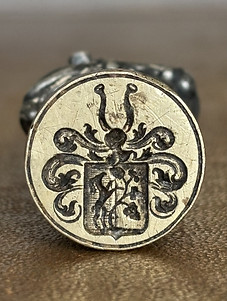


This massive metal wax seal stamp comes from Germany. Its weight and minimalist design suggest it was crafted to endure heavy or longtime use. Metal seal stamps are not always older than wooden ones. In fact, both materials have been used since ancient times, but for different social purposes, durability needs, and cost considerations.




This wax seal stamp was likely used in Italy during the late Baroque period, probably 1650-1750, and belonged to someone of noble status, perhaps duchess, noble lady, or abbess (due to the oval shield). The coat of arms shows a single vertical charge, possibly a sword or long arrow, rising from a mount or clouds. Stars or crosslets may also be present, though the engraving has become so worn that it is really difficult to identify. The outer border bears inscription, but equally difficult to read.

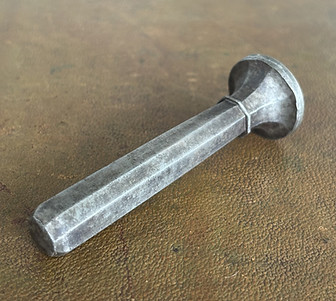
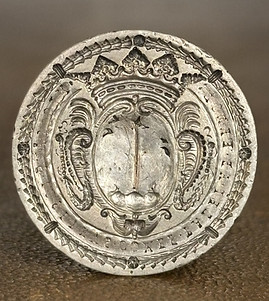
This is a seal stamp of the French family Hibon Lafresnoye. It possibly belonged more specifically to Augustin Hibon LaFresnoye (1789-1835). The handle of the stamp is made of three graduated shot balls purported to have been used during the battle of Malakoff. The largest shot ball is mounted with a metal band engraved with "Sebastopol 8 Septembre". It commemorates the capture by the French troops of the Malakhov Tower in Sevastopol, a key Russian defense during the Crimean War. This was a crucial step towards the end of the siege and the fall of Sevastopol to the allied troops. The city of Sevastopol was the home of the Tsar's Black Sea fleet, which threatened the West due to the access to the Mediterranean. The unusual shape of this stamp and the use of shot balls make it one of the most unique pieces of the collection.




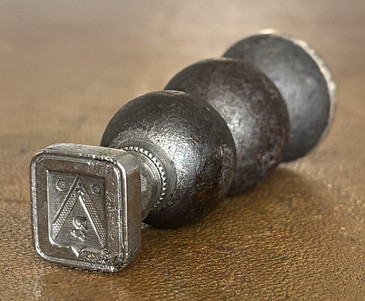

The sides of the handle of this wax seal stamp are finely chased and engraved with pastoral or allegorical scenes, all centered on graceful women in 18th-century attire. The hexagonal or tapered shape, combined with figural decoration, suggests late 18th to early 19th century, probably from France, northern Italy, or Austria. This type of decoration is rather rare on seal stamps and suggests either a highly personalized commission, possibly for a noblewoman, or a presentation gift.



While I cannot state with certainty the origin of this silver stamp, there is a German family whose coat of arms shows notable similarities to the one engraved here: the von Wrisberg family. In both the documented arms and those on the stamp, we find a bird standing on a green mount, set against a silver shield. The mantling is rendered in blue and silver. The engraving also includes a crown that resembles an early depiction of the von Wrisberg arms. The von Wrisberg are an old Lower Saxon noble family whose roots lie in the bishopric of Hildesheim, or Niedersachsen, Germany, in the present days. The family takes its name from the village or estate of Wrisbergholzen, near Alfeld (Lower Saxony), and the earliest documented mentions of the family date back to the 13th century.

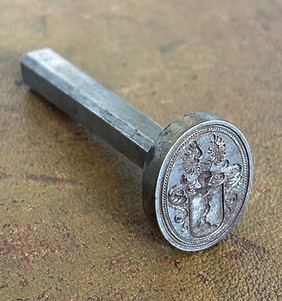



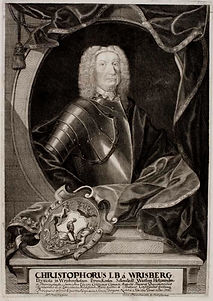

I put this little stamp with a glass handle and a metal base in the Silver Collection... for the simple reason that there is no "glass collection". It is an exception to the collection, since it is not engraved with a coat of arms but with a monogram. However, I decided to acquire it because I find the engraving very elegant looking. The red stone show a few dents, but this is normal for old stamps. If you zoom into the engraving, I am sure you will like it too. It comes from Italy.
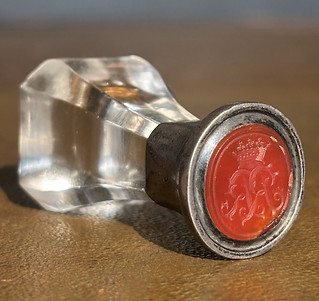


This is an exquisite example of a 19th-century aristocratic wax seal stamp, crafted by the prestigious E. & R. Altenloh, jewelers and goldsmiths "Joailliers de la Cour" (Jewelers to the Court) in Brussels. Made of silver, it is engraved with the arms of the de Tornaco family. The de Tornaco family originally comes from the region around Liège, in Belgium. For instance, Charles Auguste de Tornaco (1763-1837) was born and died at the castle of Vervoz near Clavier (Liège). In 1738 the family was ennobled (created Barons) by Emperor Charles VI in the Habsburg Netherlands, indicating their noble status in the region of Liège. However, Victor de Tornaco (1805-1875), who was born in Arlon (then French or now Belgian territory), became a Luxembourgish politician, serving as Prime Minister of the Grand-Duchy of Luxembourg from 1860 to 1867. So, a branch of the family naturally became part of the Luxembourg’ political and social elite.





Baron Victor de Tornaco (1805-1875)

Coat of arms of the Tornaco family sculpted in stone

Baron Camille de Tornaco (1807-1880)
An interesting silver seal stamp that comes from England. After some cleaning, the coat of arms revealed nice details. A mountain, two cinquefoils, and a sun, with beautiful eagles as supporters. A coat of arms with mountains may identify a family or territory located in a mountainous region, which is really common in England. So, the stamp may well come from another country. In Italy, Austria, or Slovakia, for example, mountains are more common in heraldry.



This stamp is engraved with the arms of the German Barons of Fechenbach. The family held the lordship of Laudenbach (Miltenberg district) from 1315 until the extinction of the male line in 1907 with the death of Friedrich Karl Konstantin von Fechenbach. This Catholic family belonged to the Imperial Knighthood, within the Franconian knightly canton of Odenwald. Karl Konstantin von Fechenbach had been elevated to the rank of Imperial Count (Reichsgraf) in 1790. A second line of the house held the lordship of Sommerau. Among its notable members was Johann Reichard von Fechenbach (1657–1717), an imperial field marshal who fought in the Turkish Wars under Prince Eugene at the beginning of the 18th century. The most prominent bearer of the name, however, was Georg Karl von Fechenbach (1749–1808), the last Prince-Bishop of Würzburg.



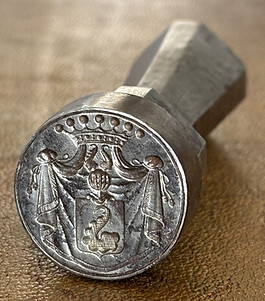
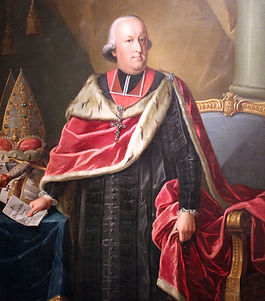.jpg)
Prince-Bishop Georg Karl von Fechenbach (1749-1808)

Arms of Johann Philipp Karl Anton von Fechenbach
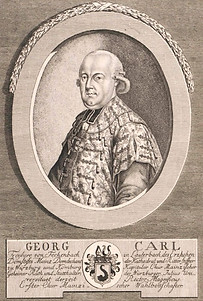
Portrait of Georg Karl von Fechenbach
This seal belonged to the Sulzer family of Winterthur, Switzerland. I acquired it from a family member, and I hope that she will appreciate the stamp being shown in my collection. It is difficult to know exactly who the stamp originally belonged to. It is naturally open to speculations, but Baroness Fanny Louise von Sulzer-Wart was a Swiss noblewoman born on 29 July 1848 in Winterthur. Could the "L" on the coat of arms stand for Louise? Just a wild guess.



This metal stamp comes from the same source as the previous one, but unlike that example, it bears an alliance coat of arms. The arms of the von Fechenbach family - those of the husband - are very clearly recognizable. Those of the spouse, however, are more complex: a quartered shield bearing at its center an inescutcheon Gules (red) charged with a single‑headed eagle. While the attribution of the complete arms remains to be discovered, the first and fourth quarters relate to the von Hettersdorf family. The two families were indeed connected by the marriage of Johann Reinhard von Fechenbach (b. 1591) with Anna Magdalena von Hettersdorf, his first wife, and both their arms appear at the moated castle of Sommerau. The arms in the remaining quarters have not yet been identified, and further research is required.






Genealogy that includes the alliance of Georg Adolf, Baron von Hettersdorf with the Barons von Fechenbach's family.

Arms of the von Fechenbach and von Hettersdorf families at the moated castel of Sommerau.
This vermeil seal stamp, acquired from Belgium, is set with lapis lazuli and turquoise cabochons and decorated with lion heads in a classical style. While likely not very old, it may not even be Belgian. The crest features a horse’s head between wings, suggesting a more Germanic influence. Nevertheless, it is a nice addition to the collection. The coat of arms is surmounted by a helmet oriented sideways, typically associated with gentlemen or lower-ranking nobles, as opposed to the front-facing helmets reserved for higher nobility.



As the alliance coat of arms indicates, this finely crafted silver seal stamp belonged to Count Paul Le Grelle and his wife, Simone Agie de Selsaeten. Their marriage in 1924 united two established Belgian noble families. Paul (1889–1972), son of Albéric Le Grelle and Marguerite de Melotte de Lavaux, came from a lineage rooted in Antwerp’s historic patriciate. Simone descended from the Agie de Selsaeten family, recognized within the Belgian nobility. The Le Grelle family had been active in Antwerp’s commercial life since the eighteenth century, and their position in trade later contributed to the creation of Banque Le Grelle, founded by Gérard le Grelle, which became a respected financial institution in the country. The union of Paul and Simone thus represented not only the joining of two noble houses, but also the meeting of families closely linked to both traditional social standing and the economy.


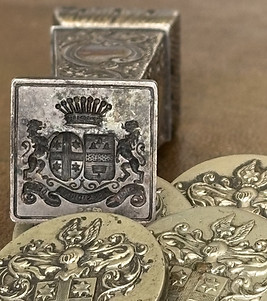


.jpg)
Joseph Guillaume Le Grelle (1795-1880)
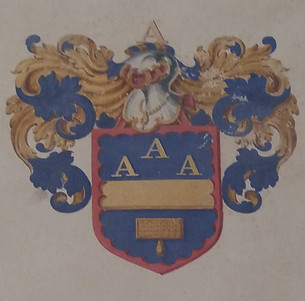
Coat of arms of the Le Grelle family

Castle of Selsaeten
Gerry's Collection of Antique Seal Stamps.



